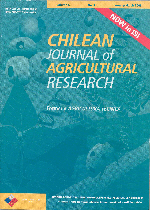
|
Agricultura Técnica
Instituto de Investigaciones Agropecuarias, INIA
ISSN: 0365-2807
EISSN: 0365-2807
Vol. 65, No. 4, 2005, pp. 378-387
|
 Bioline Code: at05041
Bioline Code: at05041
Full paper language: Spanish
Document type: Research Article
Document available free of charge
|
|
|
Agricultura Técnica, Vol. 65, No. 4, 2005, pp. 378-387
| en |
Evaluation of pine bark and urban wastes as components of plant growth media
Zapata, Nelson; Guerrero, Francisca & Polo, Alfredo
Abstract
Composted pine ( Pinus pinea

L.) bark, alone and mixed at 15 and 30% with compost of municipal solid wastes, compost of sewage sludge from urban waste water, and granulated dehydrated sewage sludge from urban waste water, were evaluated as plant growth media. To this end, chemical, physical, hydro-physical, phytotoxic properties, as well as pollution potential of their leachates were evaluated. Composted pine bark proved to have very restrictive physical and hydro-physical properties, in order to be used as plant growth media. With the addition of compost from municipal solid wastes, physical and hydro-physical properties were improved, nevertheless, when 30% was added, high phytotoxicity and potentially polluting leachates were considerable. The addition of compost from sewage sludge substantially improved physical and hydro-physical deficiencies, furthermore, no growth inhibitory effect was observed, and reduced levels of potential polluting leachates were detected. The addition of granulated sewage sludge worsened the physical and hydro-physical properties, increased phytotoxicity, and in addition its leachates were the most polluting. According to the evaluations conducted, the substrate formulated with compost of sewage sludge, at 15 and 30%, and compost of municipal solid wastes at 15% turned out to be most recommendable.
municipal solid wastes, sewage sludge, growth media, leachates.
|
| |
| es |
Evaluación de corteza de pino y residuos urbanos como componentes de sustratos de cultivo
Zapata, Nelson; Guerrero, Francisca & Polo, Alfredo
Resumen
Corteza de pino ( Pinus pinea

L.) compostada, sola y en mezcla al 15 y 30% con compost de residuos sólidos urbanos, compost de lodo de aguas residuales urbanas, y lodo granulado deshidratado de aguas residuales urbanas, fueron evaluados como sustratos de cultivo. Para estos efectos se estudiaron sus propiedades químicas, físicas, hidrofísicas y fitotóxicas, además del potencial contaminante de sus lixiviados.La corteza de pino compostada presentó propiedades físicas e hidrofísicas muy limitantes para su empleo como sustrato. Con la incorporación de compost de residuos sólidos urbanos se mejoraron las propiedades físicas e hidrofísicas del sustrato, sin embargo, cuando se adicionó al 30% se presentó elevada fitotoxicidad y lixiviados potencialmente contaminantes;la adición de compost de lodo de aguas residuales mejoró sustancialmente las deficiencias físicas e hidrofísicas, no se observó fitotoxicidad, además sus lixiviados presentaron reducido potencial de contaminación; la adición de lodo granulado de aguas residuales urbanas empeoró las propiedades físicas e hidrofísicas, presentó elevada fitotoxicidad, además sus lixiviados fueron los más contaminantes. De acuerdo con las evaluaciones efectuadas, el empleo de compost de lodo de aguas residuales urbanas al 15 y 30% y el compost de residuos sólidos urbanos al 15% resultaron ser los más recomendables.
residuos sólidos urbanos, lodos, sustratos de cultivo, lixiviados.
|
| |
© Copyright 2005 - Instituto de Investigaciones Agropecuarias, INIA (Chile)
Alternative site location: http://www.inia.cl/at/agritec.htm
|
|
